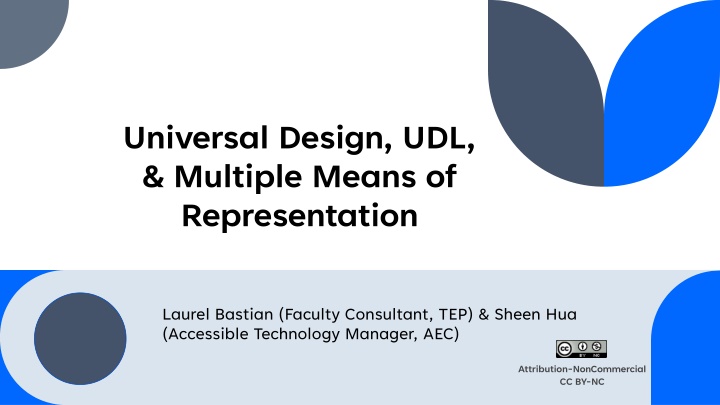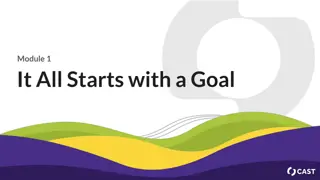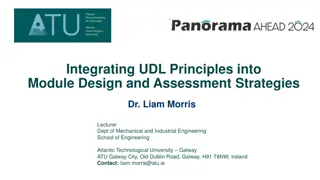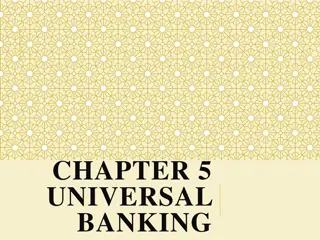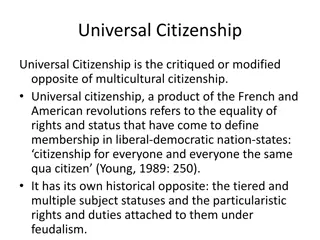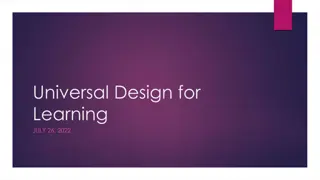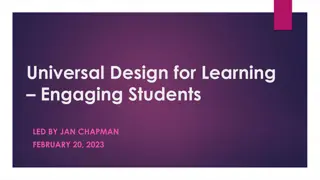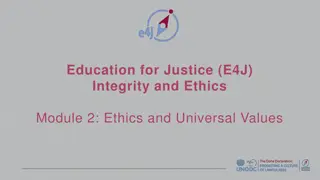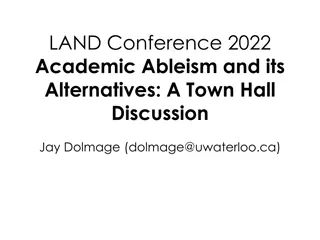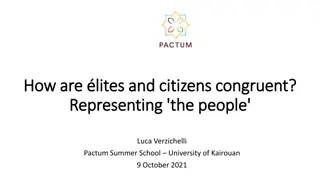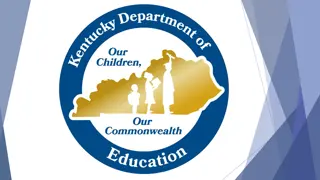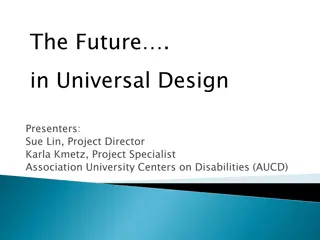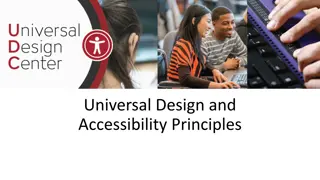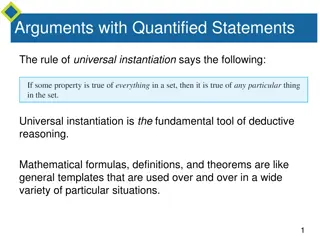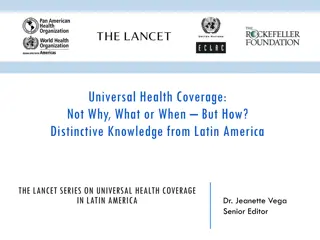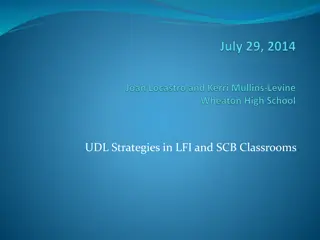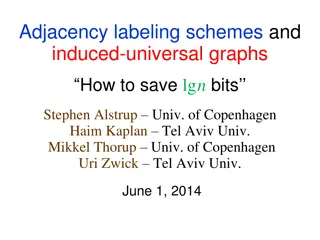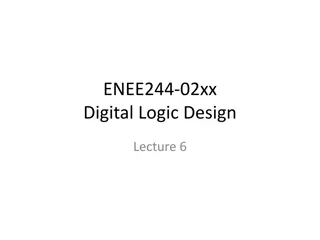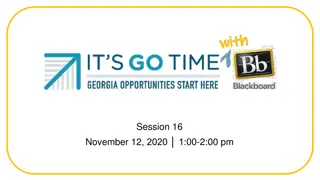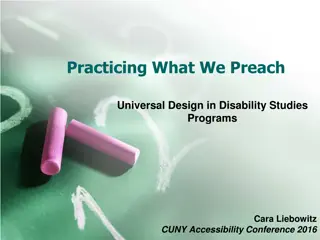Universal Design for Learning (UDL) and Multiple Means of Representation
Explore the concepts of Universal Design for Learning (UDL) and Multiple Means of Representation in education. Learn about the importance of representation in learning, how to apply multiple means of representation, and practical strategies to enhance learning inclusivity. Engage in discussions and activities to improve understanding and implementation of UDL principles.
Download Presentation

Please find below an Image/Link to download the presentation.
The content on the website is provided AS IS for your information and personal use only. It may not be sold, licensed, or shared on other websites without obtaining consent from the author.If you encounter any issues during the download, it is possible that the publisher has removed the file from their server.
You are allowed to download the files provided on this website for personal or commercial use, subject to the condition that they are used lawfully. All files are the property of their respective owners.
The content on the website is provided AS IS for your information and personal use only. It may not be sold, licensed, or shared on other websites without obtaining consent from the author.
E N D
Presentation Transcript
Universal Design, UDL, & Multiple Means of Representation Laurel Bastian (Faculty Consultant, TEP) & Sheen Hua (Accessible Technology Manager, AEC) Attribution-NonCommercial CC BY-NC
Agenda Goals & Introduction Definition and overview of UDL & Universal Design Representation: what it is, and why it matters The roles of perception, language and symbols, and comprehension" in learning How to apply "multiple means of representation" (scenarios) Setting one goal
After this session, participants will be more able to: 1. Characterize what Universal Design for Learning and representation are & why they're used 2. Identify the role representation plays in learning (including as a barrier to it) 3. Use concepts of a) revisiting learning objectives & b) plus one thinking to select an area to apply additional representation options to
Invitation to participate! Please participate in whatever way feels comfortable. For example, you might use: Your voice, at any point (feel free to unmute) Chat, raised hand, and/or reactions Your image on camera (or not) Email to contact us afterwards (lbastian@uoregon.edu)
Introduction Share your name (and pronouns if you wish) and finish one of the following: By the time I leave this session, I hope I know how to... One accommodation I've noticed students needing lately is... One of the ways I prefer having information represented to me is...
Two things to keep in mind: 1. Start with the goals 2. Embrace "plus one" thinking Before making changes, set or revisit learning objectives. What do we want students to know or know how to do after engaging with the content? Tobin and Behling say that we can think of UDL as: Something we can incrementally do! Adding just one more way (to represent material, to engage students, etc.)
Definition and overview of UDL & UD
Universal Design for Learning (UDL) is: Described by the AEC (and defined by the Higher Education Opportunity Act of 2008) as a framework that: A. provides flexibility in the ways information is presented, in the ways students respond or demonstrate knowledge and skills, and in the ways students are engaged; and B. reduces barriers in instruction, provides appropriate accommodations, supports, and challenges, and maintains high achievement expectations for all students, including students with disabilities and students who are limited English proficient. (Section 103 (24)"
Universal Design for Learning (UDL) is: a framework that addresses the primary barrier to fostering expert learners within instructional environments: inflexible, one-size-fits-all curricula. (CAST, 2011)
Universal Design for Learning (UDL): Is deeply informed by: Universal Design (initially an architectural movement) A belief that disability is not a lack or a medical problem in an individual; disability is a mismatch between an individual (who may have a health condition) and an environment (social, physical, digital, etc.) that does not work for or excludes them.
At UO, 10% of students have accommodations through AEC; nationally, an estimated 20% undergraduates have a disability.
Student identities and disabilities might include: ADHD Autistic Dyslexic Deaf Blind or visually impaired Mental health disabilities Mobility disabilities Chronic health conditions Many more We will not always know that specific students are disabled and neurodivergent, but we can assume that in every class/context, disabled and neurodivergent students are present and design options for representation.
3 UDL guidelines: multiple means of Engagement Representation Action & Expression Provide options for Perception Language and symbols Comprehension Provide options for Physical action Expression and communication Executive functions Provide options for Recruiting interest Sustaining effort and persistence Self-regulation
3 UDL guidelines: multiple means of Engagement Representation Action & Expression Provide options for Perception Language and symbols Comprehension Provide options for Physical action Expression and communication Executive functions Provide options for Recruiting interest Sustaining effort and persistence Self-regulation
Representation: what it is, and why it matters
Representation is: Necessary to consider because of learner variability. Learners differ in the ways that they perceive and comprehend information that is presented to them. For example, those with sensory disabilities (e.g., blindness or deafness); learning disabilities (e.g., dyslexia); language or cultural differences, and so forth may all require different ways of approaching content. (CAST, 2018)
Representation is: [ ] the process of collecting and presenting information to students in a way that students can understand, engage with and learn from. (Novak, 2021)
Q: What (if anything) makes multiple means of representation a challenge in your context?
UDL guidelines offer options for: Representation Provide options for Perception Language and symbols Comprehension
Components of representation: perception, language & symbols, comprehension 20
Representation offers options for: Perception Language & symbols Comprehension
Representation offers options for: Perception Interact with flexible content that doesn't depend on a single sense like sight, hearing, movement, or touch.
Representation offers options for: Example of offering one option vs multiple: Perception Interact with flexible content that doesn't depend on a single sense like sight, hearing, movement, or touch. Only one option not universal design! Laurel scans chapters of a book, making image-based pdfs to post, not considering that this is a barrier for students with visual impairments and/or who use text to speech software as part of their learning. Multiple options towards universal design! Laurel requests ebooks of the course text from the UO library and checks that the text is accessibly formatted. Find more illustrations of perception on Carleton s UDL Series Blog.
Representation offers options for: Language & symbols Clarify vocab, symbols, syntax, and structure. Support decoding of text across languages and mathematical notation.
Representation offers options for: Language & symbols Example of offering one option vs multiple: Only one option (boo!) Laurel uses new vocab, including acronyms, without explaining students will look them up if unfamiliar. Multiple options: Laurel spells out acronyms and links to two definitions for each important term. She offers a low/no-stakes quiz so students can check comprehension. Clarify vocab, symbols, syntax, and structure. Support decoding of text across languages and mathematical notation.
Representation offers options for: Comprehension Activate background knowledge; highlight patterns, relationships, critical features; guide information processing; maximize transfer.
Representation offers options for: Example of offering one option vs multiple: Only one option Lecture and encourage students to take notes. Multiple options: Prep: Reflect on why I want students to take notes (to capture content? To pick out most important concepts and begin drawing connections between them? For ex, if both, could post basic lecture outline in Word, & during lecture, pause and prompt students to identify key points to fill in, and support students in last several minutes of class in summarizing 1 or 2 key connections between them Comprehension Activate background knowledge; highlight patterns, relationships, critical features; guide information processing; maximize transfer.
Representation guidelines work together Perception Language & symbols Comprehension Clarify vocab, symbols, syntax, and structure. Support decoding of text across languages and mathematical notation. Activate background knowledge; highlight patterns, relationships, critical features; guide information processing; maximize transfer. Interact with flexible content that doesn't depend on a single sense like sight, hearing, movement, or touch.
How to apply "multiple means of representation" 29
Applying this to your context Identify one place in your course that there s a pain point or a challenge for students (and likely for you) that might relate to representation. This "pain point" could be in Canvas, in a lecture, an assignment, related to understanding a concept. It might be something you get many questions about from students. Once you identify the challenge, we'll talk together about it (including identifying the learning goal)
How might applying one more option help us decrease this "pain point"? Perception Language & symbols Comprehension Clarify vocab, symbols, syntax, and structure. Support decoding of text across languages and mathematical notation. Activate background knowledge; highlight patterns, relationships, critical features; guide information processing; maximize transfer. Interact with flexible content that doesn't depend on a single sense like sight, hearing, movement, or touch.
How might applying "representation" guidelines help us (question version) What is the goal I have for sharing this content in this situation? How does this support our learning objectives? Can we separate the goal (why we want students to do X) from the means? How might the guidelines in representation help us identify a challenge in the scenario How might the checkpoints help us identify an option we could use to create multiple means? Any UO resources we need to know about that would support us?
Contact uslet's talk UDL!
